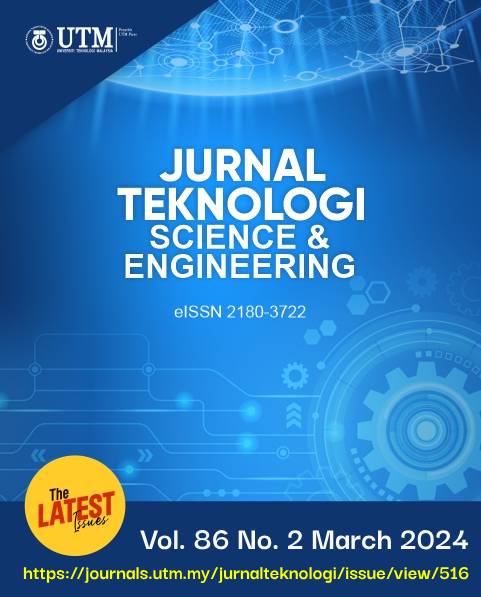COMPARISON OF FLEXURAL PROPERTIES OF PINEWOOD WITH FEA SIMULATION FOR MARINE APPLICATION
DOI:
https://doi.org/10.11113/jurnalteknologi.v86.20667Keywords:
Activated carbon, resin, flexural, finite element analysisAbstract
Pine wood sourced from pellet packaging, being abundant, holds potential for utilization in creating bio composites, particularly as activated carbon for laminated coatings in structural applications. However, there is a current lack of research identifying its specific properties as a coating material for Fiber Reinforced Polymer (FRP) composites. Fiber Reinforced Polymer (FRP) composites provide a highly adaptable solution for reinforcing and revitalizing existing structures in challenging marine conditions. This study delves into investigating the flexural characteristics of FRP pine wood composites, comparing the findings with Finite Element Analysis (FEA) results. Furthermore, the activated carbon derived from pine wood exhibits potential for resisting barnacle attachment when immersed in saltwater. For the flexural analysis, samples were produced using a silicone rubber mold, incorporating varying weight percentages (wt.%) of activated FRP pine wood, ranging from 2 wt.% to 10 wt.%. The outcomes of the study reveal that the introduction of activated carbon from pine wood leads to an enhancement in ultimate strength, reaching a maximum of 2700 MPa. Nonetheless, the results also indicate a reduction in material strength as the proportion of activated carbon pine wood is increased.
References
Chellis R. Deterioration and Preservation of Piles. Pile Found. 1961: 339-72.
Li, X., Wang, J., Bao, Y., Chen, G. 2017. Cyclic Behavior of Damaged Reinforced Concrete Columns Repaired with High-performance Fiber-reinforced Cementitious Composite. Eng Struct. 136: 26-35.
Azam, R., El-Sayed, A. K., Soudki, K. 2016. Behaviour of Reinforced Concrete Beams without Stirrups Subjected to Steel Reinforcement Corrosion. J Civil Eng Manage. 22(2): 146-53.
Hollaway, L. 2008. Advanced Fiber Polymer Composite Structural Systems used in Bridge Engineering. ICE Manual Bridge Eng. 34525.
Gholami, M., Sam, A. R. M., Yatim, J. M., Tahir, M. M. 2013. A Review on Steel/CFRP Strengthening Systems Focusing on Environmental Performance. Constr Build Mater. 47: 301-10.
Manalo, A. C., Karunasena, W., Sirimanna, C., Maranan, G. B. 2014. Investigation into Fiber Composites Jacket with an Innovative Joining System. Constr Build Mater. 65: 270-81.
Vandoros, K. G., Dritsos, S. E. 2008. Concrete Jacket Construction Detail Effectiveness when Strengthening RC Columns. Constr Build Mater. 22(3): 264-76.
Beddiar, A., Zitoune, R., Collombet, F., Grunevald, Y., Abadlia, M., Bourahla, N. 2015. Compressive Behavior of Concrete Elements Confined with GFRP- Prefabricated Bonded Shells. Eur J Environ Civil Eng. 19(1): 65-80.
AlAjarmeh, O., Manalo, A., Benmokrane, B., Karunasena, W., Mendis, P., Nguyen, K. 2019. Compressive Behavior of Axially Loaded Circular Hollow Concrete Columns Reinforced with GFRP Bars and Spirals. Constr Build Mater. 194: 12-23.
Vijay, P., Soti, P. R., GangaRao, H. V., Lampo, R. G., Clarkson, J. D. 2016. Repair and Strengthening of Submerged Steel Piles using GFRP Composites. J Bridge Eng. 04016038.
FAO. 2016. Global Forest Products / Facts and Figures. http://www.fao.org/3/i7034en/i7034en.pdf.
Astari, L., K. W. Prasetiyo, and L. Suryanegara. 2018. Properties of Particleboard Made from Wood Waste with Various Size. IOP Conference Series: Earth and Environmental Science.
Lias, H., et al. 2014. Influence of Board Density and Particle Sizes on the Homogenous Particleboard Properties from Kelempayan (Neolamarckia cadamba).
Nasser, R. A., et al. 2014. Effects of Tree Species and Wood Particle Size on the Properties of Cement-bonded Particleboard Manufacturing from Tree Prunings. Journal of Environmental Biology. 35(5): 961-971.
Miyamoto, K., S. Nakahara, and S. Suzuki. 2002. Effect of Particle Shape on Linear Expansion of Particleboard. Journal of Wood Science. 48(3): 185- 190.
Sackey, E. K., et al. 2008. Improving Core Bond Strength of Particleboard through Particle Size Redistribution. Wood and Fiber Science. 40(2): 214-224.
Mujika. F. 2020. Three-Point Bending Test Procedure: Rectangular Rectangular Cross Section. Materials and Technologies Group. University of the Basque Country.
Salleh. Z., et al. 2014. Mechanical Properties of Activated Carbon (AC) Coconut Shell Reinforced Polypropylene Composites Encapsulated with Epoxy Resin. APCBEE Procedia. 92-96.
Downloads
Published
Issue
Section
License
Copyright of articles that appear in Jurnal Teknologi belongs exclusively to Penerbit Universiti Teknologi Malaysia (Penerbit UTM Press). This copyright covers the rights to reproduce the article, including reprints, electronic reproductions, or any other reproductions of similar nature.
















